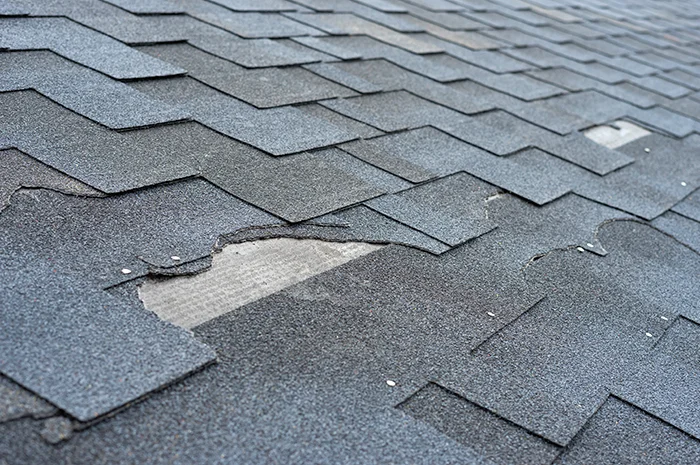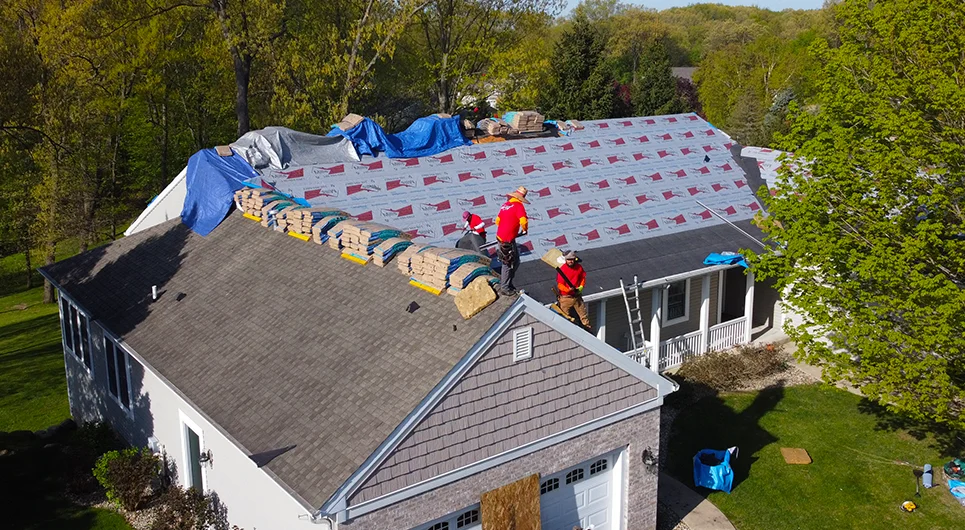Not all storm damage is easy to spot—and sometimes, what looks like minor issues could be symptoms of much larger problems. If you’re a homeowner in Michigan or Ohio, it’s especially important to know when your roof has suffered enough damage to require more than just a quick repair. Replacing your roof after a storm can be a big investment, but it’s often necessary to protect your home from future leaks, mold, and structural damage.
In this guide, we’ll explore the top five warning signs that indicate your roof may need a full replacement—and why it’s worth acting fast if you see any of them.
1. Multiple Missing or Lifted Shingles
Storms with strong winds or hail often cause shingles to loosen, lift, or completely tear off. Missing shingles leave your underlayment and roof decking exposed to moisture. Once water gets in, it can lead to rot, mold, and insulation damage.
If you notice missing shingles across multiple areas of your roof—or if entire sections look uneven or curled—this may indicate widespread failure, not just isolated damage. Repairs might work temporarily, but if the structural integrity of the roof has been compromised, replacement is the safer, long-term solution.
In areas like Toledo, Cleveland, or Grand Rapids, where storms can roll in with little notice, this kind of damage is particularly common after high-wind events.
2. Leaks in Your Attic or Ceiling
One of the most obvious signs that your roof has storm-related damage is water appearing where it shouldn’t. After a major storm, check your attic and ceilings for:
- Water stains or damp spots
- Peeling paint
- Dripping or pooled water
Leaks often signal that water has penetrated the roofing layers—usually due to compromised shingles, underlayment, or flashing. Even if you see just a small leak, it’s worth scheduling a full inspection. Water can travel along rafters and beams, so the source of the leak might be far from where it appears.
Left unaddressed, leaks can lead to mold, mildew, and even electrical hazards.
3. Granule Loss and Bald Spots on Shingles
Hailstorms are a leading cause of granule loss in asphalt shingles. Those small granules help protect the shingles from UV rays and water damage. When they’re knocked off in patches, your shingles are left exposed—and far more likely to fail prematurely.
Check your gutters, downspouts, and even the base of your driveway for accumulations of granules after a storm. You might also notice bald patches on the roof surface. This is a major red flag, especially if your shingles are relatively new.
Granule loss can’t be repaired—it’s a form of irreversible damage. When widespread, it’s a strong signal that a full replacement is needed.

4. Daylight Coming Through the Roof Boards
If you can see sunlight streaming through the boards in your attic, it’s a sure sign that your roof’s decking has been compromised. While this isn’t always storm-related, high winds, flying debris, or ice damming can all lead to splits, holes, or rot.
This type of damage often goes unnoticed until homeowners either check their attic or suffer a major interior leak. If you see daylight, it’s time to call a professional immediately.
In colder parts of Michigan and northern Ohio, freeze-thaw cycles can also contribute to structural breakdown over time—especially if the roof was already damaged during a previous storm.
5. Insurance Adjuster or Contractor Recommends Full Replacement
Sometimes, the signs are there—but they aren’t visible to the untrained eye. That’s why having a professional contractor inspect your roof after a storm is essential. If both your contractor and insurance adjuster agree that the damage is widespread, patching just isn’t worth the risk.
Full roof replacements may be covered entirely by your homeowners insurance, minus your deductible. If your contractor provides clear documentation of storm-related damage—photos, measurements, and a scope of work—it’s much easier to secure claim approval.
Working with a contractor who understands the claims process (like Mills) can help ensure you receive a fair evaluation and maximum coverage.
Why Replacing May Be Better Than Repairing
While minor repairs can extend the life of your roof, they’re often just temporary fixes—especially if the underlying structure has already begun to deteriorate. A full replacement offers:
- Long-term protection from leaks
- Full manufacturer warranty coverage
- Improved energy efficiency
- Better resale value
- Peace of mind during future storms
In some cases, continuing to patch an old or heavily damaged roof only delays the inevitable—and may cost you more in the long run if water damage spreads.
What the Roof Replacement Process Looks Like
At Mills Siding & Roofing, we aim to make the replacement process as stress-free as possible. Here’s what you can expect:
- Free Inspection: We assess your roof’s condition and identify storm-related damage.
- Documentation for Insurance: We provide photos, measurements, and a detailed estimate.
- Adjuster Coordination: We meet with your insurance adjuster to ensure nothing is missed.
- Claim Approval: Once approved, we review the scope of work with you.
- Scheduling and Installation: Our team schedules your replacement and completes the job efficiently.
- Final Walkthrough: We ensure the quality of work and your satisfaction.
We use high-quality materials and follow local building codes in every job, whether it’s in Detroit, Kalamazoo, Cleveland, or anywhere in between.
Common Questions About Roof Replacement
Q: How do I know if my roof is too damaged to repair?
A: If more than 25–30% of the roof is affected, or if structural damage is present, most professionals recommend replacement. Your insurance may agree.
Q: How long does a roof replacement take?
A: Most replacements take 1–2 days depending on size and weather conditions.
Q: Will my homeowner’s insurance cover a new roof?
A: If the damage is storm-related and documented properly, yes—many policies will cover the full cost minus your deductible.
Q: Should I wait until leaks appear to consider replacement?
A: No—by the time leaks are visible, serious internal damage may already have occurred. Preventative action is better and often covered.
Final Thoughts
Your roof is your home’s first line of defense against the elements. After a storm, it’s easy to overlook damage—especially if everything looks fine from the street. But the signs listed above are strong indicators that your roof may be compromised. A professional inspection is the best way to determine whether repair or replacement is the right choice.
At Mills Siding & Roofing, we specialize in storm restoration and work directly with insurance companies across Michigan and Ohio to make the process as smooth as possible.
Not sure if your roof needs replacing? Book a free consultation with Mills and we’ll give you honest, expert advice—no pressure, just facts. Protect your home before the next storm hits.
